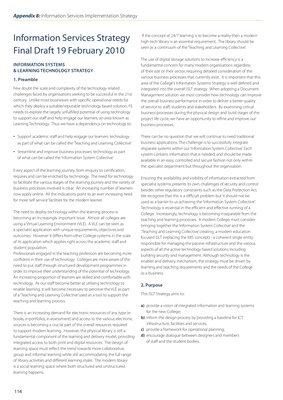
Appendix 8: Information Services Implementation Strategy
114
Information Services Strategy
Final Draft 19 February 2010
INFORMATION SYSTEMS
& LEARNING TECHNOLOGY STRATEGY
1. Preamble
Few doubt the scale and complexity of the technology related
challenges faced by organisations seeking to be successful in the 21st
century. Unlike most businesses with specii c operational needs for
which they deploy a suitable/reputable technology based solution, FE
needs to explore the largely unfuli lled potential of using technology
to support our staf and help engage our learners, an area known as
Learning Technology. Thus we have a dependency on technology to:
Support academic staf and help engage our learners: technology
as part of what can be called the 'Teaching and Learning Collective'
Streamline and improve business processes: technology as part
of what can be called the 'Information System Collective'
Every aspect of the learning journey, from enquiry to certii cation,
requires and can be enriched by technology. The need for technology
to facilitate the various stages of the learning journey and the variety of
business processes involved is clear. An increasing number of learners
now apply online. All the indications point to an ever increasing need
for more 'self service' facilities for the modern learner.
The need to deploy technology within the learning process is
becoming an increasingly important issue. Almost all colleges are
using a Virtual Learning Environment (VLE). A VLE can be seen as
a specialist application with unique requirements, objectives and
outcomes. However it dif ers from other College systems in the scale
of its application which applies right across the academic staf and
student population.
Professionals engaged in the teaching profession are becoming more
coni dent in their use of technology. Colleges are more aware of the
need to put staf through structured development programmes in
order to improve their understanding of the potential of technology.
An increasing proportion of learners are skilled and comfortable with
technology. As our staf become better at utilising technology to
enable learning, it will become necessary to perceive the VLE as part
of a 'Teaching and Learning Collective' used as a tool to support the
teaching and learning process.
There is an increasing demand for electronic resources of any type (ebooks,
e-portfolios, e-assessment) and access to the various electronic
sources is becoming a crucial part of the overall resources required
to support modern learning. However, the physical library is still a
fundamental component of the learning and delivery model, providing
integrated access to both print and digital resources. The design of
learning space must rel ect the trend towards more collaborative,
group and informal learning while still accommodating the full range
of library activities and dif erent learning styles. The modern library
is a social learning space where both structured and unstructured
learning happens.
•
•
If the concept of 24/7 learning is to become a reality then a modern
high-tech library is an essential requirement. The library should be
seen as a continuum of the 'Teaching and Learning Collective'.
The use of digital storage solutions to increase ei ciency is a
fundamental concern for many modern organisations regardless
of their size or their sector, requiring detailed consideration of the
various business processes that currently exist. It is important that this
area of the College's Information Systems Strategy is well dei ned and
integrated into the overall ISLT strategy. When adopting a Document
Management solution we must consider how technology can improve
the overall business performance in order to deliver a better quality
of service to staf , students and stakeholders. By examining critical
business processes during the physical design and build stages of the
project life cycle, we have an opportunity to rei ne and improve our
business processes.
There can be no question that we will continue to need traditional
business applications. The challenge is to successfully integrate
disparate systems within our 'Information System Collective'. Each
system contains information that is needed, and should be made
available in an easy, controlled and secure fashion not only within
the specialist department but throughout the organisation.
Ensuring the availability and visibility of information extracted from
specialist systems presents its own challenges of security and control
besides other regulatory constraints such as the Data Protection Act.
We recognise that this is a dii cult problem but it should not be
used as a barrier to us achieving the 'Information System Collective'.
Technology is essential in the ei cient and ef ective running of a
College. Increasingly, technology is becoming inseparable from the
teaching and learning processes. A modern College must consider
bringing together the 'Information System Collective' and the
'Teaching and Learning Collective' creating a modern education
focused ISLT (replacing the MIS concept) - a coherent single entity
responsible for managing the passive infrastructure and the various
aspects of all the active technology based solutions including
building security and management. Although technology is the
enabler and delivery mechanism, the strategy must be driven by
learning and teaching requirements and the needs of the College
as a business.
2. Purpose
This ISLT Strategy aims to:
a) provide a vision of integrated information and learning systems
for the new College;
b) inform the design process by providing a baseline for ICT
infrastructure, facilities and services;
c) provide a framework for operational planning;
d) encourage dialogue between designers and members
of staf and the student bodies.